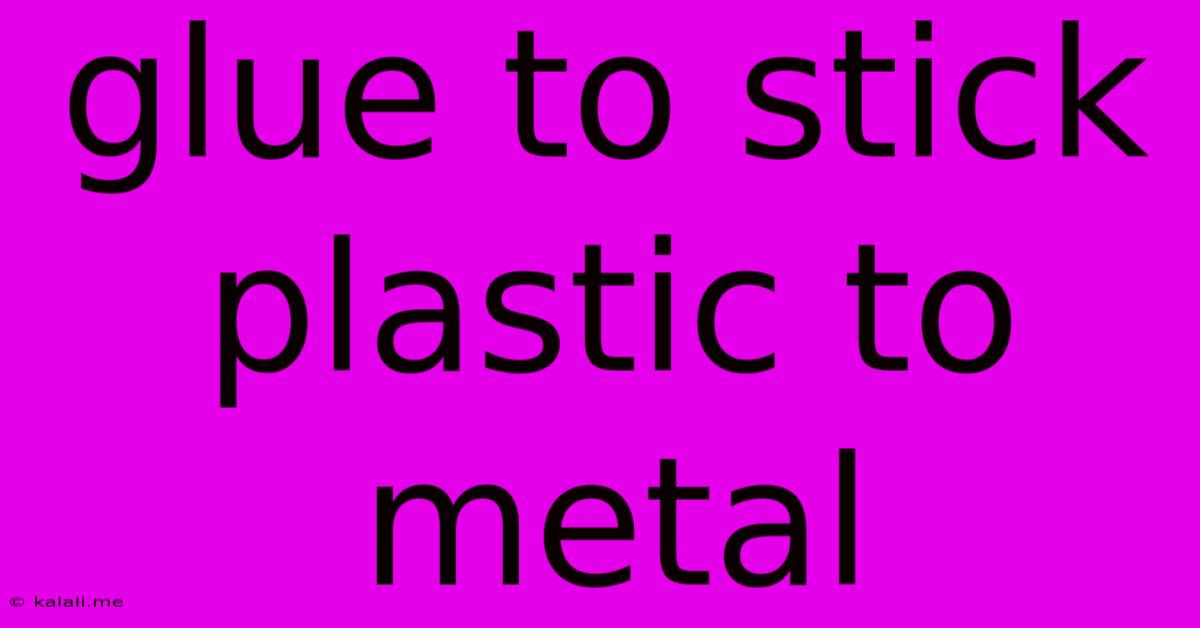Glue To Stick Plastic To Metal
Kalali
May 22, 2025 · 3 min read

Table of Contents
The Ultimate Guide to Gluing Plastic to Metal: Choosing the Right Adhesive for a Strong Bond
Finding the right glue to stick plastic to metal can be tricky. Unlike gluing similar materials, the differing surface properties of plastic and metal require a specialized adhesive for a strong, lasting bond. This guide explores various adhesive types, preparation techniques, and application tips to ensure a successful project, whether you're repairing a broken appliance or creating a unique craft.
Understanding the Challenges: The key challenge lies in the dissimilar surface energies of plastic and metal. Plastics, often non-porous, can be difficult for adhesives to penetrate and adhere to properly. Metals, conversely, can be smooth and non-reactive with certain adhesives. Therefore, proper surface preparation is crucial for a successful bond.
Choosing the Right Adhesive: A Comparison of Options
Several adhesive types excel at bonding plastic to metal, each with its strengths and weaknesses:
-
Epoxy: A versatile two-part adhesive system, epoxy offers excellent strength and durability. It's ideal for high-stress applications and works well with a wide range of plastics and metals. Key advantage: high strength, resistance to various environments. Potential drawback: longer curing time.
-
Cyanoacrylate (Super Glue): Fast-setting and convenient, super glue provides a quick bond. It's suitable for smaller projects and less demanding applications. Key advantage: fast curing time, easy application. Potential drawback: lower strength compared to epoxy, susceptible to certain chemicals and temperatures.
-
Polyurethane Adhesive: This type of adhesive offers excellent flexibility and is particularly useful when bonding plastics to metals with different expansion rates, helping to prevent stress cracking. Key advantage: flexibility, strong bond. Potential drawback: Longer curing time compared to super glue.
-
Acrylic Adhesive: Acrylic adhesives, including many construction adhesives, can create a strong bond depending on the specific formulation. Always check the manufacturer's instructions to ensure compatibility with your chosen plastic and metal. Key advantage: Often versatile and readily available. Potential drawback: Can be less strong than epoxy or polyurethane, depending on formulation and application.
Preparing Surfaces for Optimal Adhesion
Surface preparation is paramount. Improper preparation will result in a weak bond, regardless of the adhesive used. Follow these steps:
-
Cleaning: Thoroughly clean both the plastic and metal surfaces with a degreaser or isopropyl alcohol. Remove any dirt, grease, oil, or dust. This ensures the adhesive can make proper contact.
-
Roughening (Optional): For some plastics and smoother metals, lightly roughening the surfaces with sandpaper (fine grit) can improve adhesion. This creates more surface area for the adhesive to grip. Avoid excessive sanding, which could weaken the material.
-
Priming (Sometimes Necessary): In some cases, a specialized primer might be necessary to improve the adhesive's hold on the plastic or metal surface. Refer to the adhesive manufacturer's instructions for specific recommendations.
Application Techniques for Success
-
Apply Evenly: Distribute the adhesive evenly across both surfaces. Avoid excessive amounts, as this can lead to excess squeeze-out and a weaker bond.
-
Clamp or Secure: After applying the adhesive, firmly clamp or secure the two parts together. Ensure even pressure across the entire bonding area to prevent air pockets and achieve optimal contact.
-
Curing Time: Allow sufficient curing time as specified by the adhesive manufacturer. Avoid disturbing the bond during this period.
Choosing the Right Glue for Your Project
The best glue for your specific needs depends on several factors, including:
- The type of plastic and metal: Some adhesives work better with certain plastic and metal combinations. Always check compatibility charts provided by adhesive manufacturers.
- The strength required: For high-stress applications, epoxy is preferred. For less demanding projects, super glue might suffice.
- The environment: Consider the temperature and chemical exposure the bond will face. Choose an adhesive with appropriate resistance.
By following these guidelines, you can confidently select and apply the correct adhesive to create a strong, durable bond between plastic and metal. Remember to always consult the manufacturer's instructions for specific recommendations and safety precautions.
Latest Posts
Latest Posts
-
Ductless A C Re Insulation For Fedder Lines From Compressor
May 23, 2025
-
Clay Strips Tool Is Not Working
May 23, 2025
-
Can I Take Earlier Bus On Megabus Baltimore
May 23, 2025
-
Too Many Levels Of Symbolic Links
May 23, 2025
-
Replace Dumb Quotes With Smart Quotes
May 23, 2025
Related Post
Thank you for visiting our website which covers about Glue To Stick Plastic To Metal . We hope the information provided has been useful to you. Feel free to contact us if you have any questions or need further assistance. See you next time and don't miss to bookmark.